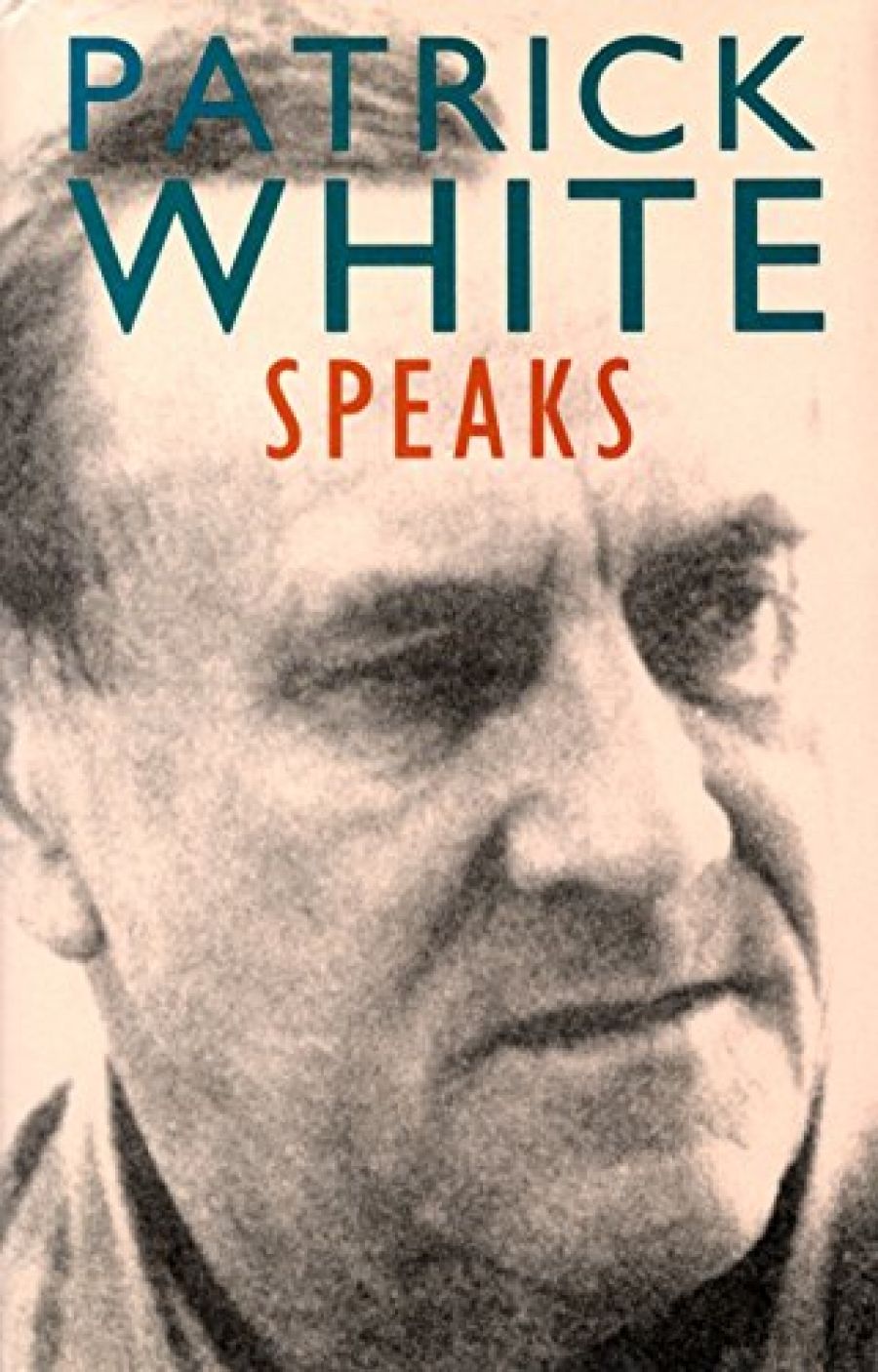
- Free Article: No
- Contents Category: Anthologies
- Review Article: Yes
- Online Only: No
- Custom Highlight Text:
In the early 1970s, Patrick White began to achieve a new public identity. His support for the fight to save Centennial Park from Olympic developers, his endorsement of the Whitlam government, and, of course, his receipt of the Nobel Prize for Literature in 1973 transformed a writer aiming ‘to people the Australian emptiness in the only way I am able’ into a personality able to persuade (and irritate) merely by his presence. The outsider suddenly became an insider – in 1973 he was ‘unanimously chosen’ as Australian of the Year – and, to his mingled dismay and delight, he discovered that Australia was already peopled.
- Book 1 Title: Patrick White Speaks
- Book 1 Biblio: Primavera Press, 208 pp, $16.95pb
Then, in 1981, White began lending his pen and his voice to the cause of nuclear disarmament. The imminent prospect of the death of life on earth provided an overwhelming practical reason for speaking out. But in the fight to overcome the threat of nuclear war White also saw the Australian dilemma magnified: it was people, not politicians, who would lead us away from the brink towards a saner future. But the moral strength to achieve this was inseparable from a sense of ‘identity’. Finding the resolve to resist Reagan’s blandishments, Australians might not only contribute to a nuclear-free future: they would in the process free themselves of the ‘claptrap about the need for a national identity’. ‘Australia,’ he observed in 1983, ‘will never acquire a national identity until enough individual Australians acquire identities of their own’.
What could be more predictable from the author of Voss and The Solid Mandala than this stress on the individual conscience? But in the context of the speeches, interviews, and open letters published in Patrick White Speaks, the idea of an individual illumination, that change-about in the heart which mystics (and writers) describe, immune to the politics of self-interest, which constantly prevents White from subsiding into misanthropy. People en masse appeal him. To speak publicly distorts speech, reducing the emotional colours of experience to a general drabness. One senses in many of the speeches printed here the writer absenting himself from the concerned citizen, consciously suppressing prose rhythms in the interests of immediate clarity. (Although never, surely, did White speak in the stop-go staccato Craig McGregor attributes to him in his monologue ‘In the Making’, also printed here.) Against this prosaic realism, White cleaves to a belief in the irreducible strangeness of individual experience, a sense of selfhood that is perhaps also a sense of style.
Even people taken individually disgust him; for White regards individuality not as a natural birthright but as an inner potential, a spiritual gift. The goal of life is to realise this gift. His hatred is reserved for those who achieve only a material differentiation of themselves. Hence, despite his call for a democratic Australian republic, an almost ungovernable repulsion overcomes him when he contemplates its likely constituents – the man who doesn’t care whether the park is saved, the people who wear sweatshirts with slogans, the kids who watch the box and are cynical. His disgust is an index of his despair: how can you get close to ghosts?
The writer’s task, as he indicated in a speech given at Australian Book Week in 1980, is not to document external details, but to realise the inner world:
It has always troubled me that so many Australian novelists are content to explore an autobiographical vein instead of launching into that admittedly disturbing marriage between life and imagination.
But, as it emerges from some of his later speeches, a paradox attends this adventurous marriage: to discover one’s individuality is to slough off selfhood; it is to achieve inner vacancy or calm, of which the active counterpart is found in the passive resistance practised by Gandhi, and which White advocates in the face of the nuclear threat.
Patrick White’s politics, like his aesthetics, is profoundly undialectical. He doesn’t believe in an opposition between individual and society, between biography and history. Rather one is inscribed within the other, and the external trappings of time and place merely imitate (or mock) the identity concealed within. ‘I believe,’ he says in ‘A Sense of Integrity’ (1980), ‘most people hunger after spirituality, even if that hunger remains in many cases unconscious’. Hence, possibly, the outer emptiness conceals an inner emptiness, only the latter is a form of spiritual grace, a peculiarly Australian state of metaphysical scepticism that is also a form of self-knowledge.
Many will question White’s analysis of the Australian condition. The emptiness he finds at its heart depends on filtering out the babble of voices, Aboriginal and other, that have struggled to be heard ever since 1788. White’s metaphysical beliefs have quite material origins in human oppression. To transcend the past, it is not enough to have a vision. The vision must be historically informed. Without listening to the other voices, our painfully achieved sense of individual identity may only isolate us further from the truth about ourselves, our past and future.
But the more than thirty public statements collected in Patrick White Speaks are not only a valuable addition to White’s biography: they are a moving testimony – flaws and all –to one man’s understanding of the writer’s social responsibility. As one individual’s efforts to influence the future in every way he can, they are even more admirable.


Comments powered by CComment